From the Library
PALMISTRY
In the Library at Charlecote there is a collection of books that
was slowly accumulated from the Sixteenth century. Some of the earliest
books are somewhat inaccessible as they are small and tucked away
on the top shelves requiring a step or ladder to reach them. A day
was set aside for exploring these, leading to the discovery of some
interesting books presented in this talk. There are two sixteenth
century books on Palmistry or Chiromancy (from the Greek for hand
and divination). The Lucys were clearly very interested in this because
I found two later books and they wrote notes in them.
Some volunteer guides expressed surprise at the presence of these
books because they thought palmistry would have been equated with
Witchcraft. I supposed that it was possible that Thomas Lucy 1, as
the local magistrate, might have had to prosecute for palmistry so
would need to have knowledge of it – hence the books (but there
is no merit in this supposition– see later). The whole subject
required my further study using the standard reference: ‘The
book of the Hand’ by Fred Gettings published in 1965.
Palmistry is an ancient study and Gettings states that the History
of Palmistry is really the History of Superstition. There is no such
thing as Palmistry – only Palmists, but over the centuries palmists
observed what they thought to be definite features which were then
woven into the tradition of palmistry. It is certainly not a science
based on fact but has been described as an art, running alongside
alchemy. The interest shown in it is because it was thought palmists
could discern the future and everybody is interested in that, with
the palm readers maintaining that ‘Your future is in your hands’.
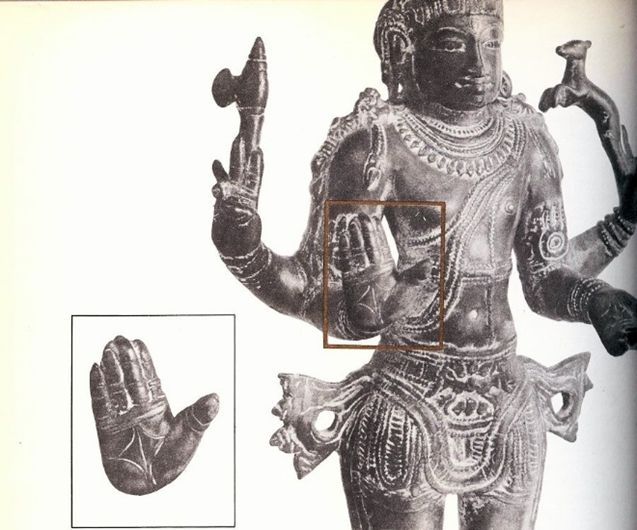
The earliest references to palmistry are in Indian Vedic writings
which have been carefully preserved and were thought to be revelations
passed down as an oral tradition by ancient sages. Veda is Sanskrit
for knowledge. They stretch back to over 1000 years before Christ.
The first writings only appeared during the first century BC. Palmistry
also existed in Chinese writings from 400BC. Palmistry was thought
to be so important that Indian statues of the gods had palm prints
but being of divine origin these had to be completely different from
those of ordinary mortals –see photo. It was only in the thirteenth
century that detailed Chiromantic manuscripts emerged, most of which
are now in the British Museum or Bodleian library, Oxford. However
these texts were rather short being just notes as reminders for the
oral delivery.
It was in the fifteenth century that there were claims, particularly
in Protestant countries, that palmistry was witchcraft. This was countered
by the defence that as it had descended from Aristotle, or earlier,
it could not be witchcraft. (I am not sure I understand the logic
of that). At the same time as it was being derided as witchcraft in
this country the study of palm reading was being taught at the University
of Leipzig . By the 16th Century palmistry was wide-spread in Europe
mainly due to wandering gypsies.
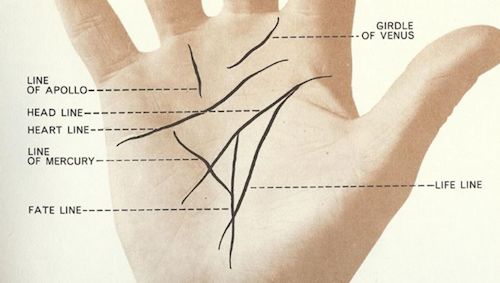
I am not a palmist but I suppose I must say something about the art
or technique – in this I am summarising chapters of information
in Gettings’ book. . Imagine your hand divided into four by a
line coming straight down your middle finger and a horizontal line
just above the thumb. The side of the hand containing the thumb is
deemed to represent the interaction with external life and strength
of will, ambition and power of dominance. The half containing the
little finger represents the opposite; the inner life of emotions
and inwardly directed energy. Looking at the other division of the
hand the top half contains the fingers and this section relates to
intelligence. The lower half relates to primitive factors such as
instinct. The picture shows the main lines on the hand although palmistry
is just as concerned with the areas in between (known as the mounts)
and the overall shape of the hands and fingers.
There are four main lines. The life line encloses the mount of Venus
(the area at the base of the thumb) Apparently the length of the line
does not reflect the length of a persons life but instead reflects
the amount of energy the person has or will have – the energy
potential. Any breaks in the line indicate trauma ahead. The head
line addresses mental abilities and again can predict any traumas.
The heart line is concerned with the affairs of the heart and can
record emotional experiences. The Fate line is known as the line of
Saturn and is the line of destiny.
The fundamental working out of Palmistry was done in the fourteenth
century and fifteenth century books tended just to repeat this information
with no new material. It was in the sixteenth century that new palmists
emerged and biographies and autobiographs were produced so that we
know more about them as human beings. To quote Gettings, they were
typical early Renaissance scholars with an enquiring awareness in
multicultural disciplines. Some of the outstanding ones were Cocles,
Achillinus, Tibertus, Antiochus, and Paracelsus.
Pronuntiations: Cocles ( Co as in cope not cock). Achilllinus ( Aa_chill
– in – us), Tibertus ( Tib_bert_us) Antiochus ( An_tie_o_chus
as in choose), and Paracelsus (Para-sell-suss).
Barthelmy Cocles was also known as Andreas Corvus.
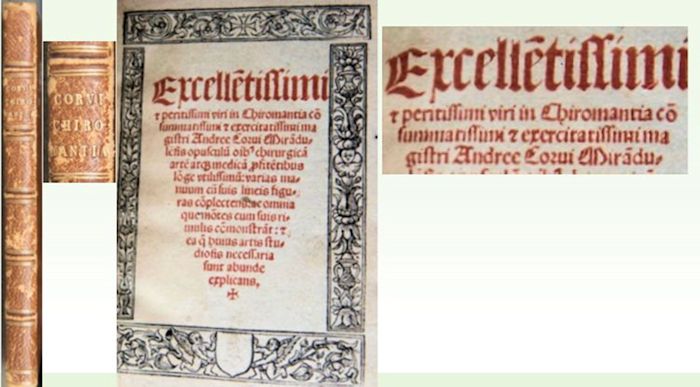
This is the earliest Palmistry book in the Charlecote library. In
Chiromantis Magister by André Corve (1520 first published in
Venice in 1510). Spelling of names seems to be approximate at best
so Andre Corve can be Andreas Corvus but he is also known as Barthelmy
Cocles . These books are incredibly rare and valuable. A translation
of this title page is
A little book by the most excellent and experienced man in chiromancy,
the most practised master Andreas Corvus of Mirandola, a book about
the surgical and medical art, for a long time most useful to those
able to profit from it. Complete with varied [types of] hands and
line drawings of them and everything that the ridges and creases demonstrate,
and full explanations of everything necessary to artistic studies.
The comma at the end implies that the title continues on the next
page which we neglected to photograph.: they loved long titles because
they advertised the book which you would originally see laid out on
a stall and buy unbound, specifying your own binding.
There are four pictures of palms at the end of the book.
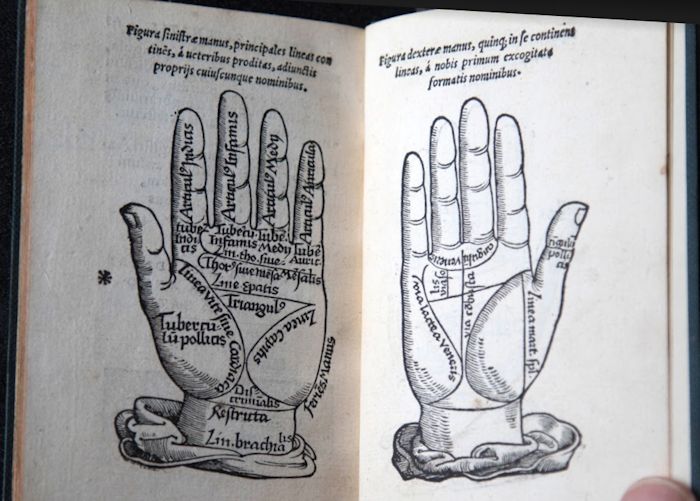
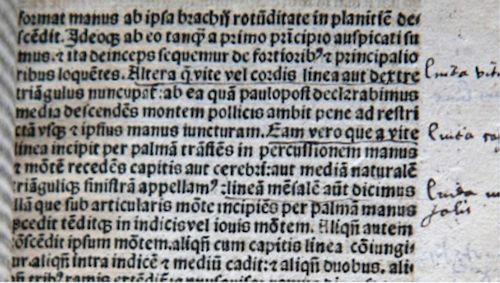 They
clearly studied this book, underlining parts and annotating in the
margins. The annotations appear to be in latin but I could not decipher
them clearly enough to translate them. But it does make the point
that they took the study of palmistry very seriously.
They
clearly studied this book, underlining parts and annotating in the
margins. The annotations appear to be in latin but I could not decipher
them clearly enough to translate them. But it does make the point
that they took the study of palmistry very seriously.
So seriously that in 1850 somebody took the trouble to translate
this book. Annoyingly they did not sign the translation. I will hazard
a guess that it was Mary Elizabeth because George would have been
dead for five years and she might well be concerned with what lay
in the future.

The other Sixteenth century book is from slightly later, 1538 although
the colophon indicates it was actually first published in 1494.
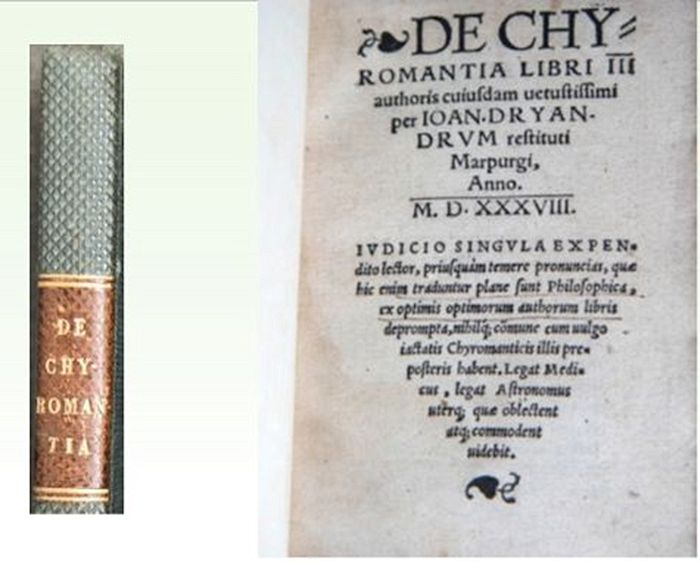
The translation of this title page reads
Three books about chiromancy (palm reading) by a certain very ancient
author restored by Johannes Dryander of Marburg in the year 1538.
Having exercised singular judgement, reader, before you dare to give
judgement, the philosophical matters that are transmitted here are
clearly derived from the best books by the best authors, in no way
derived from common and preposterous forms of chiromancy. Let both
doctors and astronomers (astrologers) read; the result will be pleasant
and useful.
Dryander was Professor of Medicine at the University of Marburg and
wrote the first textbook on the anatomy of the brain based upon his
own observations.
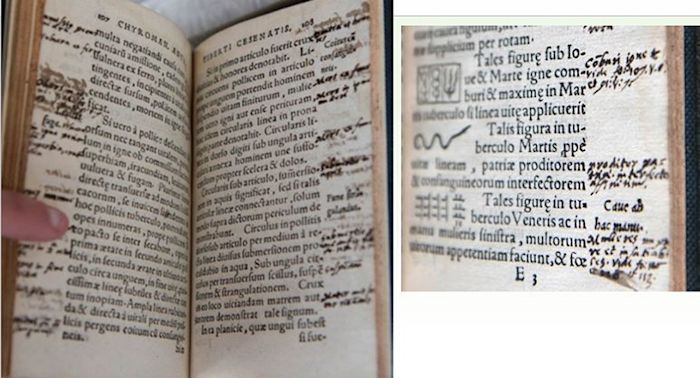
Notice this book is illustrated and heavily annotated in Latin but
the combination of the handwriting and the language render it illegible
to me.
Our final book on Palmistry was published by Ina Oxenford in 1899.
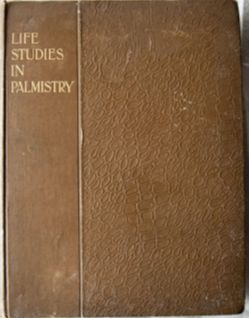 The
London Cheirological Society of Great Britain had been established
in 1889 by Katherine St Hill who was then joined by Ina Oxenford and
the publisher Charles Rideal. [Rid-Eel]. Its aim was to apply scientific
research to Palmistry. The Society established Courses and Examinations
and functioned as a professional body. By 1892 it had sufficient members
to warrant the publication of its own Journal, The Palmist.
It was very popular being sold by W H Smith and other booksellers
and on railway station news-stands. Ina Oxenford acted as treasurer
and secretary and contributed articles. She wrote four books but they
all tended to be regurgitation of earlier authors.
The
London Cheirological Society of Great Britain had been established
in 1889 by Katherine St Hill who was then joined by Ina Oxenford and
the publisher Charles Rideal. [Rid-Eel]. Its aim was to apply scientific
research to Palmistry. The Society established Courses and Examinations
and functioned as a professional body. By 1892 it had sufficient members
to warrant the publication of its own Journal, The Palmist.
It was very popular being sold by W H Smith and other booksellers
and on railway station news-stands. Ina Oxenford acted as treasurer
and secretary and contributed articles. She wrote four books but they
all tended to be regurgitation of earlier authors.

Ada Christina has inscribed the fly-leaf with ‘The proper study
of mankind is man’ which is a quote from a Poem by Alexander
Pope “An Essay of Man” which is in his collected works in
the Charlecote Library. It is dated 1900 so I presume it is a presentation
copy to her husband of 8 years, Sir Henry Cameron Ramsey Fairfax
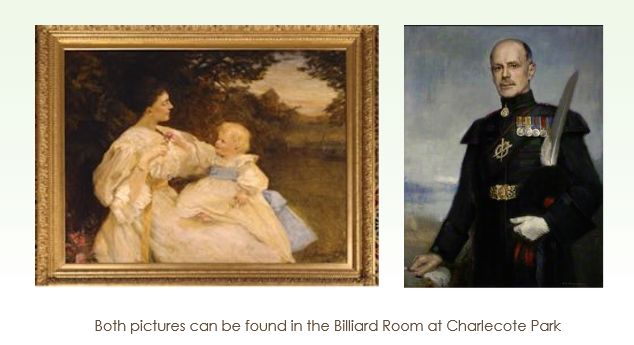
Lady Ada Christina shown here with her son William who died in 1910
aged 15 painted by George Harcourt in 1896. Ada was Sir Edmund Fairfax
Lucy’s Grandmother. Sir Henry Cameron Ramsey Fairfax Lucy was
a baronet and brought the title ‘Sir’ back into the Lucy
family. He is shown in the uniform of the Royal company of Archers
and they were charged with maintaining the safety of the Sovereign
when she was in Scotland.
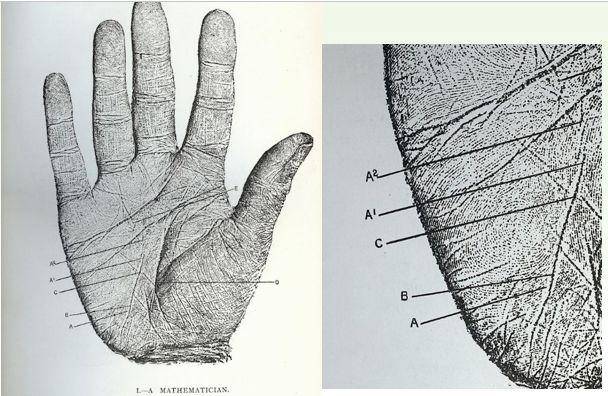
The quality of the hand prints in this Life Studies in Palmistry
show a marked improvement over the sixteenth century images.
Ina Oxenford said “From the earliest ages of which we have record
there have been some who have paid great attention to hands, and by
much study have learned not only to judge the character, but to read
past events, and even profess to foretell the future. Of late years
there has been a great revival of the study (she was writing in 1899),
Different writers have compared readings, and these readings have
been verified in large numbers of hands, so that year by year the
results have become more exact.
Ina Oxenford, Katherine St Hill and Charles Rideal toured hospitals,
mental institutions and schools in order to examine as many different
types of hands as possible taking plaster impressions of the palms.
Whatever the serious intent they undermined it by offering palm readings
at Garden Fetes and private parties so Palmistry was not seen as a
serious study but as a party trick.
Life studies in Palmistry contains a gallery of hand prints from 26
individuals of different backgrounds and professions for instance:
a mathematician, a Judge, A Clergyman, A Doctor, a Sea-Captain, A
Dressmaker, a Circus Rider and a mad person.
Looking at just one aspect of the hand of the Mathematician they
noted two breaks at A1 and A2 , the latter of which appears to be
a new development and leads to increase in money. That is made as
a bold but unsupported statement however he is then said not to care
for money as shown by the flat third phalanges. In my copy of this
book the previous owner has underlined this and placed a question
mark. Indeed they might. The phalanges are the bones in the fingers
and are normally marked Distal (tip), middle and proximal. I assume
the number Ina uses places 1 as the distal or end bone so the flattening
she observes is in the proximal regions of the fingers. I don’t
really want to stand here rubbishing her work but these are totally
unsupported statements.

The hand of a Judge.
‘Well formed, well balanced, with the straight first finger,
firm long thumb, evenly balanced second phalanx, the hands showed
a cultivated nature, power of command, and intense determination courteously
veiled. …. The first and fourth fingers are the best developed
from the Palmist’s point of view; the former, although thick,
is not too long, and gives him the power to rule without tyranny,
but with individual force.
The thumb has a tip which betrays a great dislike to opposition, he
can be firm, but prefers settling things amicably rather than by coercion
(as shown by the slanting tip. The second phalanx is extremely remarkable
from its length, and shows the capacity for argument, which is corroborated
by the cultivated power of words shown in the developed first phalanx.
It is an analytical hand; its possessor is critical and fastidious,
difficult to convince, but ever just to his opponents.”
Of course I have not seen the years of work which have presumably
led to these pronouncements but I would have been more convinced if
it were some sort of blind test and they did not know it was a Judge’s
hand they were looking at. I could have derived the above description
of a judge without even looking at his hands.
As a scientist I am totally sceptical of the whole “art”
of Palmistry and I think we better move on to something else. That
said I once went to a palmist in a booth just for the ‘Hell of
it’ and emerged rather shaken by the accuracy of some of the
comments made and some of the future prediction certainly did come
true.
Len Mullenger is a Sunday volunteer
guide. Any comments are welcome and can be sent to len@musicweb-international.com






 They
clearly studied this book, underlining parts and annotating in the
margins. The annotations appear to be in latin but I could not decipher
them clearly enough to translate them. But it does make the point
that they took the study of palmistry very seriously.
They
clearly studied this book, underlining parts and annotating in the
margins. The annotations appear to be in latin but I could not decipher
them clearly enough to translate them. But it does make the point
that they took the study of palmistry very seriously.


 The
London Cheirological Society of Great Britain had been established
in 1889 by Katherine St Hill who was then joined by Ina Oxenford and
the publisher Charles Rideal. [Rid-Eel]. Its aim was to apply scientific
research to Palmistry. The Society established Courses and Examinations
and functioned as a professional body. By 1892 it had sufficient members
to warrant the publication of its own Journal, The Palmist.
It was very popular being sold by W H Smith and other booksellers
and on railway station news-stands. Ina Oxenford acted as treasurer
and secretary and contributed articles. She wrote four books but they
all tended to be regurgitation of earlier authors.
The
London Cheirological Society of Great Britain had been established
in 1889 by Katherine St Hill who was then joined by Ina Oxenford and
the publisher Charles Rideal. [Rid-Eel]. Its aim was to apply scientific
research to Palmistry. The Society established Courses and Examinations
and functioned as a professional body. By 1892 it had sufficient members
to warrant the publication of its own Journal, The Palmist.
It was very popular being sold by W H Smith and other booksellers
and on railway station news-stands. Ina Oxenford acted as treasurer
and secretary and contributed articles. She wrote four books but they
all tended to be regurgitation of earlier authors.


